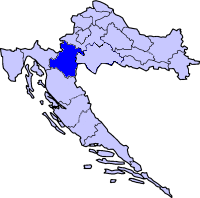Croatia is divided into twenty-one counties (županija) and the capital Zagreb's city district (in italics below):
Zagreb (pronounced: ) is the capital and largest city of Croatia. Zagreb is the cultural, scientific, economic, political and administrative center of the Republic of Croatia with the houses of Parliament, President and Government of the country. The city's population in 2001 was 779,145 [1]. (1,088,841 in the metro area).[2]. It is situated between the southern slopes of the Medvednica mountains and the northern bank of the Sava river at an elevation of 120 m above sea level, located at .
Zagreb is the cultural, scientific, economic, political and administrative center of the Republic of Croatia with the houses of Parliament, President and Government of the country. The city's population in 2001 was 779,145 [1]. (1,088,841 in the metro area).[2]. It is situated between the southern slopes of the Medvednica mountains and the northern bank of the Sava river at an elevation of 120 m above sea level, located at .
Its favourable geographic position in the southwestern part of the Pannonian Basin, which extends to the Alpine, Dinaric, Adriatic and Pannonic regions, provides an excellent connection for traffic between Central Europe and the Adriatic Sea.
The transport connections, concentration of industry, scientific and research institutions and industrial tradition underlie its leading economic position in Croatia. Zagreb is the seat of the central government, administrative bodies and almost all government ministries.




















